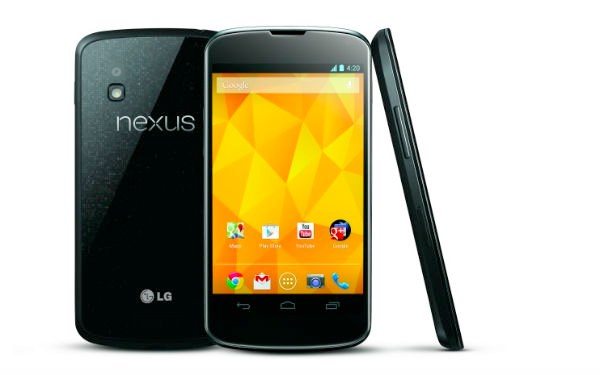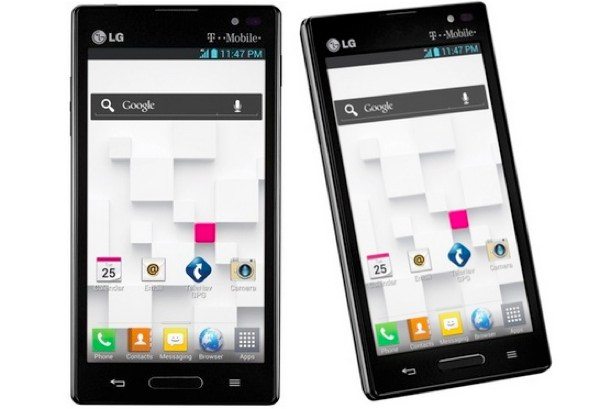Nexus 4 vs Optimus L9, the LG review clash
With the holiday season upon us we are endeavoring to bring readers as much news as possible about new and upcoming smartphones and today we want to compare two new LG handsets. We are going to look at the Nexus 4 vs. Optimus L9 in an LG review clash to hopefully give you some guidance on what might be the best choice for you.
The Optimus L9 has a T-Mobile variant for the US and has just released while the Nexus 4 is to be released tomorrow and is available through the Google Play Store. The Optimus L9 is a mid-range phone while the Nexus 4 is generating a lot of interest as it is the next Google Nexus smartphone and will be released running the very latest Android 4.2 Jelly Bean OS. We’ll take a look at some of the key specs and features of each one before taking a lot at what some of the reviews have to say.
Firstly the Nexus 4 and this phone has a 1.5GHz Qualcomm quad-core Krait processor, a 4.7-inch True HD IPS Plus display with resolution of 1280 x 768 and 318ppi, 2GB of RAM but only 8 or 16GB storage options, non-expandable via microSD. We’ve posted many, many articles now about the LG Nexus 4 and the lack of internal storage seems to be one of its only flaws although it does also lack LTE connectivity.
Other specs include an 8-megapixel rear camera with 1080p video capture and the brand new PhotoSphere feature plus a 1.3-megapixel front-facing camera and there’s also a 2100mAh battery, Wi-Fi 802.11 a/b/g/n, DLNA, Wi-Fi hotspot and Bluetooth v4. As we’ve already mentioned it will be out of the box with Android 4.2 Jelly Bean. This is extremely reasonably priced for such high-end specs as it will be available to order for only $299 for the 8GB version or $349 for the 16GB version. Prices are for the unlocked Nexus 4 through the Google Play Store.

Next up is the LG Optimus L9 and this is aimed more at the mid-range of the market and has a 1GHz dual-core processor, a 4.5-inch IPS LCD display with resolution of 960 x 540 and 245ppi, 1GB of RAM and 4GB of internal storage, expandable via microSD up to 32GB. There’s also a 5-megapixel rear camera with 1080p video capture as well as a VGA front-facing camera, plus a 2150mAh battery, Wi-Fi 802.11 a/b/g/n, Wi-Fi Direct, Wi-Fi Hotspot, DLNA and Bluetooth v3. The Optimus L9 will release on Android 4.0.4 Ice Cream Sandwich and again there’s no LTE connectivity. This one is priced at $79.99 on the usual two-year contract.
A brief glance through the specs shows that in virtually every respect the Nexus 4 beats the Optimus L9, such as with a more powerful processor, better display, later operating system, superior camera, extra RAM and more. The Optimus L9 does have expandable storage though and is also very reasonably priced. If you want the Nexus 4 although you have to pay more upfront the phone is unlocked whereas for the Optimus L9 you pay less upfront but have the two-year contract to consider.
In a comprehensive Engadget review of the Optimus L9 it was decided that for a mid-range phone it was “more than acceptable” but although performance was decent enough there was criticism that the battery only gave around 5 hours of use, and that’s pretty poor by anyone’s standards. While using it for functions that take up less juice though, such as taking photos or web browsing, it performed better and had around 50% capacity left after 8 hours. Engadget also had plenty of criticism for the amount of bloatware thrown on the Optimus L9 by T-Mobile, using up valuable storage. All in all the conclusion was that it’s an adequate phone and the low price is a bonus but that poor battery life is something that heavy users should consider. The Nexus 4 is ultimately suggested as a superior alternative.
A PC Mag review of the Optimus L9 seemed to be more impressed though giving the phone 4 out of 5. Positives were seen as the cheap price, display, processor and call quality while the light and slim build also earned praise. The negatives included no voice dialing and bloatware but in conclusion it was found to offer a “great mix of features and performance.

Turning back to the LG Nexus 4 then, Engadget’s review of this phone was pretty effusive at first, describing its looks and initial rundown of specs as a “veritable dreamboat.” This extremely detailed review does detail concerns though over the benchmarks results, processor speed and also battery life but also points out that that the Nexus 4 used is a review unit and so it may be harsh to judge at this stage. Engadget points out that the price is incredible for such top-notch specs and that for a Nexus phone the price is “simply stunning.” The fact it also runs Android 4.2 Jelly Bean out of the box, the camera and other features are all reasons that this was found to be a very tempting device.
Our final review look is PC Mag’s review of the Nexus 4 and it’s interesting that a rating of 4/5 was given, the same as the site gave for the Optimus L9. Plus points include the design, display, fast performance, 4.2 Jelly Bean and more while negatives include a “mediocre camera and camcorder,” ineffective voice dialing and the fact that it gets rather warm. It’s interesting that PC Mag had criticism for the camera whereas Engadget described the camera as an “asset.” The conclusion from PC Mag was that the powerful Nexus 4 has a “beautiful minimalist design” with very decent performance and that big bonus of 4.2 Jelly Bean.
There’s an awful lot to take into account between the Nexus 4 and the Optimus L9 but hopefully this will give readers some idea of which would be the best choice for them. Taking all of this into consideration we’d really like to hear from readers about these two phones. Are you thinking of purchasing either one? If so which one and what was your deciding factor? Let us know with your comments.

Live Comment
Your email address will not be published.